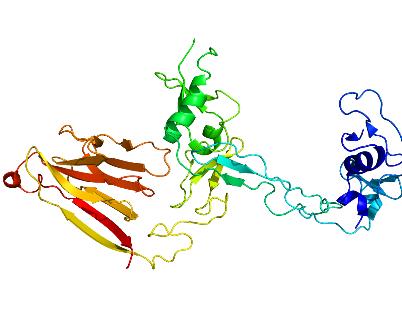Creative Biolabs is a world-leading service provider of application-specific antibody development. Here, we introduce our in vitro diagnostic (IVD) antibody development and immunoassay development services targeting the ADAMTS-13 marker. Our state-of-the-art technologies ensure that our clients receive high-quality, flexible, and cost-effective services.
ADAMTS-13
ADAMTS-13, also known as von Willebrand factor-cleaving protease (VWFCP), is a disintegrin and metalloproteinase with a thrombospondin type 1 motif, member 13. It is defined as a zinc-containing metalloprotease enzyme that cleaves von Willebrand factor (vWF) anchored on the endothelial surface, in circulation, and at the sites of vascular injury, which is a large protein involved in blood clotting. ADAMTS-13 is predominantly synthesized in the liver and then secreted in blood. It reduces large vWf multimers, declining their activity. It is characterized by an adjacent disintegrin domain, a protease domain (the part that performs the protein hydrolysis), and eight thrombospondin domains. Actually, ADAMTS1-3 has no hydrophobic transmembrane domain and thus not anchored to the cell membrane.
 Fig. 1 Sepsis-associated coagulopathy pathogenesis.1
Fig. 1 Sepsis-associated coagulopathy pathogenesis.1
The role of ADAMTS-13 in Sepsis
Endothelial dysfunction plays a crucial role in the pathophysiology of sepsis. Under normal circumstances, endothelial cells suppress coagulation, prevent platelet aggregation, and control vascular tone and permeability. During sepsis, endothelial activation leads to a pro-coagulant state which is relevant to widespread microvascular thrombosis. The von Willebrand factor (VWF) contributes to this process through mediating platelet adhesion and aggregation at the sites of vascular injury. VWF is released by the stimulated endothelium to generate the hyperactive and ultralarge von Willebrand factor. Additionally, ADAMTS-13 regulates the multimeric size and adhesive properties of VWF, which determine the different functions of VWF. ADAMTS-13 is able to cleave the UL-VWF and convert it to smaller, less active VWF multimers in circulation. Accordingly, the reduction in ADAMTS-13 activity leads to the persistence of UL-VWF and the formation of microvascular thrombi, causing microvascular ischemia and organ failure. Reduced ADAMTS-13 activity has been shown in severe sepsis and in sepsis-induced disseminated intravascular coagulation.
IVD Antibody Development Services Targeting ADAMTS-13
In recent years, IVD technology is undergoing rapid development. IVD antibodies have been widely used in immunodiagnostic tools to aid in the diagnosis of various diseases, conditions, and infections. With years of experience and advanced technology, Creative Biolabs is able to provide a full range of high-quality and cost-effective biomarker-specific antibody development services. Especially, we help develop novel anti-ADAMTS-13 antibodies for your IVD projects. Having completed a number of IVD antibody generation and development projects, Creative Biolabs is confident to offer you the best products and services to promote your project a success.
If you are interested in the services we can provide, please don't hesitate to contact us or directly send us an inquiry. We will get in touch with you as soon as possible.
Reference
- From Wikipedia: By Pleiotrope - Own work, https://commons.wikimedia.org/wiki/File:Protein_ADAMTS13_PDB_3GHM.png
For Research Use Only.

